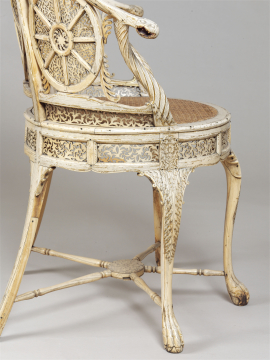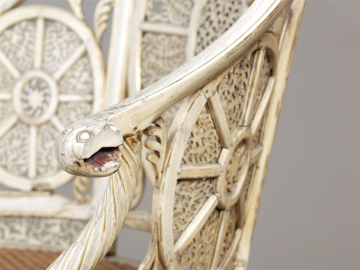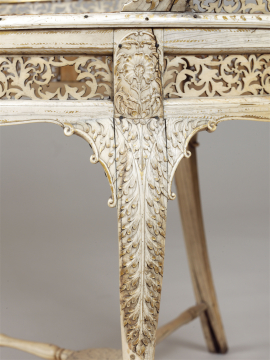Explore Collections


You are here:
CollectionsOnline
/
Armchair, ivory, unknown maker, Murshidabad, India, late eighteenth century
Browse
Armchair, one of a set including XF169-XF172, unknown maker, Murshidabad, India, late eighteenth century, solid ivory, carved, pierced and partly gilt, with rattan seats. ©Sir John Soane's Museum, London. Photograph: Hugh Kelly.
Armchair, ivory, unknown maker, Murshidabad, India, late eighteenth century
Late eighteenth century c.1780-1800
Murshidabad
Solid ivory, carved, pierced and partly gilt, with rattan seats
Height: 90cm
Width: 53cm
Depth: 43cm
Width: 53cm
Depth: 43cm
Museum number: XF170
On display: Picture Room
All spaces are in No. 13 Lincoln's Inn Fields unless identified as in No. 12, Soane's first house.
For tours https://www.soane.org/your-visit
Curatorial note
One of four (XF169-XF172) with matching table MGR2. With wheel-backs, with turned spokes separating panels of fretwork, which also runs between the seat rails. The arms, which curve outwards, rest on twisted arm supports and terminate in tiger’s heads; each chair has three front cabriole legs terminating in tiger’s paw feet and two rear legs of square-section, tapering and moderately raked; the five legs are joined by wheel-stretchers of turned spokes; the legs and the spandrel brackets are carved with stylised acanthus
Soane believed that this set had been owned by Tipu Sultan, the ruler of Mysore in southern India from 1782 to 1799, and had been seized from his palace following the fall of Seringapatam in 1799. Notes in the early Soane inventories record that they were ‘purchased at the sale of General Crewe’s effects by Richard Westmacott RA’.1 Soane probably purchased the furniture from Westmacott, a leading neoclassical sculptor and a close friend, in the early 1820s. It is always possible that Westmacott presented them to Soane especially for his new Picture Room; Westmacott was extremely proud of Soane’s placing of his ‘Nymph’ as the centrepiece when the south planes of the room were opened. Sales of General Crewe’s extensive picture collection were held by the London auctioneer Farebrother on 28-29 June and 14 and 16 July 1810. A further sale on 12-13 July, though officially anonymous like the other two, must be the sale of ‘effects’ referred to in the 1837 inventory for it included on the second day:
169 Four curious solid ivory arm chairs, cane seats, red velvet cushions
170 An oval ivory gilt table, with drawers
Both lots were purchased by ‘Mathews’, for 18 and 8 guineas respectively. Held ‘on the premises’ at 20 Lower Brook Street, Bond Street, without reserve and ‘by order of the Trustees’, the sale comprised an impressive variety of bronzes, porcelain and stained glass. The chairs and table were grouped with ‘Fine carvings in Ivory &c.’, a large category including reliefs, tankards and ‘an exquisite carving’ of the Deposition attributed to Michelangelo. The description of the chairs makes reference neither to India nor Tipu, and since General Crewe had no connection with India he may not have been the first English owner of the set. The purchaser in 1810, Mathews, has not been identified but he may have been a dealer who sold the furniture on to Westmacott, adding the Tipu provenance in the process.
It was the supposed provenance of the set that particularly appealed to Soane. In his 1835 Description he referred to them simply as ivory chairs ‘formerly in the possession of Tippoo Saib’. Mrs Hofland, the novelist whose text is included alongside Soane’s own in the Description, elaborated this further, enthusing:
Nor should the eye neglect to examine the four beautifully carved ivory chairs, once the property of Tippoo Saib. How many recollections are these chairs calculated to awaken of fallen greatness, Eastern luxury, and British valour – a valour not more happily than justly exerted against a tyrant, whose cruelty and ambition rendered him the scourge alike of his own country and of those around him! Retributive justice has scattered the proofs of his wealth and the objects of his pride through that land whose subjects he immured in the most horrible dungeons, and treated with a barbarity humanity shudders to recall, but should never cease to remember: and even these costly and delicate memorials remind us of his vices, and bid us rejoice in his fall.2
Tipu held what Moni Mohsin has called an ‘awful attraction’ for many Britons who, like Soane, had never been to India and knew relatively little of it. News of Tipu’s attempt to enlist Napoleon’s assistance in fighting the British had spurred the formation of the largest British army ever assembled in India to march on Tipu’s stronghold at Seringapatam. After a long siege, the city fell and Tipu was killed, his palaces and his collections plundered. The memory of the defeat of Tipu remained undimmed throughout the early nineteenth century – even after Waterloo – and there was a high premium on objects associated with him. Soane knew other leading collectors, such as William Beckford, who owned items with a supposed Tipu provenance.3 His close friend J.M.W. Turner produced watercolours depicting the siege of Seringapatam in c. 1800.
Amin Jaffer has shown that it is unlikely that the Soane furniture actually came from Seringapatam, where there is no record of Tipu having had any moveable furniture in the western sense (the only item of furniture mentioned in contemporary sources is his golden throne). John Britton’s reference to Soane’s chairs having belonged to Tipu4 is the earliest known example of the association of Tipu’s name with ivory furniture and may well have been seminal in the germination of the general myth of a Tipu provenance for much Indian ivory furniture. The inclusion of tiger-head motifs on such furniture and, indeed, in the case of these chairs, the modelling of the three front legs after tiger-legs, would have strengthened the association as both Tipu and his father Haider Ali (whose name means ‘tiger’) were associated with such symbolism. As Jaffer has noted, the British would have been aware of the Tipu legend but ignorant of how widespread tiger motifs are in Indian art.
In fact, the Soane furniture was almost certainly made in Murshidabad in Bengal, an important centre of ivory carving, where British influence following the Battle of Plassey in 1757 led to the manufacture of western-style objects, including furniture. Peter Thornton considered them likely to date, on stylistic grounds, from the period 1780-1800. An identical chair in the Victoria Memorial Museum in Calcutta is said to have been given to Mrs Warren Hastings by Mani Begum, wife of Nawab Mir Jafar of Murshidabad (Warren Hastings was British Resident at Murshidabad early in his career).5 Jaffer has identified a further two pairs and one single chair of similar design surviving elsewhere.6
The chairs were displayed in the Picture Room from its completion until the time of Soane’s death when they were described in the first furniture inventory as ‘4 Ivory Chairs richly carved and gilded with arms, cane seats, cushions covered with velvet and chintz covers thereto’.7 The cushions do not survive but one of the chairs is shown in the view bt J M Gandy of 1827 (Vol 82, 90) with what appears to be a crimson velvet cushion.
According to John Britton’s Union of 1827 the chairs were displayed in the ‘angles’ or corners of the room at that date. Even after the removal of the table to the Morning Room on the second floor, they must have reduced the space in the Picture Room considerably. Almost immediately after Soane’s death they were removed to the South Drawing Room by order of the Trustees, presumably because of the danger of damage from visitors.
1 1837 inventory ‘Copy 4’, p. 162.
2 Description, 1835, p. 25.
3 D. Ostergard (ed.), William Beckford, 1760-1844: An Eye for the Magnificent, New Haven and London, 2001, pp. 44-45.
4 Britton, Union, p.40. Britton’s text was overseen by Soane.
5 K. Ghose, ‘Note on Ivory Chair & Teapoy in Victoria Memorial Collection’, Bulletin of the Victoria Memorial, Vol. X, 1976, pp 53-55; K Ghose ‘Additional Note on Ivory Chair in Victoria Memorial Collection’, Bulletin of the Victoria Memorial, Vol. XII, 1979, pp. 25-27.
6 There is a pair In Hyderabad, a single chair at Hopetoun House and another pair (ex-Rothschild collection) whose whereabouts is unknown.
7 AB Inventory, Fittings and Fixtures Inventory, 1837, p. 407. Description, 1835, copy inscribed by George Bailey ‘my own rough copy’ and with his annotations, p.15 annotated in the margin ‘removed to the South Drawing Room by order of the Trustees. 1837’.
Soane believed that this set had been owned by Tipu Sultan, the ruler of Mysore in southern India from 1782 to 1799, and had been seized from his palace following the fall of Seringapatam in 1799. Notes in the early Soane inventories record that they were ‘purchased at the sale of General Crewe’s effects by Richard Westmacott RA’.1 Soane probably purchased the furniture from Westmacott, a leading neoclassical sculptor and a close friend, in the early 1820s. It is always possible that Westmacott presented them to Soane especially for his new Picture Room; Westmacott was extremely proud of Soane’s placing of his ‘Nymph’ as the centrepiece when the south planes of the room were opened. Sales of General Crewe’s extensive picture collection were held by the London auctioneer Farebrother on 28-29 June and 14 and 16 July 1810. A further sale on 12-13 July, though officially anonymous like the other two, must be the sale of ‘effects’ referred to in the 1837 inventory for it included on the second day:
169 Four curious solid ivory arm chairs, cane seats, red velvet cushions
170 An oval ivory gilt table, with drawers
Both lots were purchased by ‘Mathews’, for 18 and 8 guineas respectively. Held ‘on the premises’ at 20 Lower Brook Street, Bond Street, without reserve and ‘by order of the Trustees’, the sale comprised an impressive variety of bronzes, porcelain and stained glass. The chairs and table were grouped with ‘Fine carvings in Ivory &c.’, a large category including reliefs, tankards and ‘an exquisite carving’ of the Deposition attributed to Michelangelo. The description of the chairs makes reference neither to India nor Tipu, and since General Crewe had no connection with India he may not have been the first English owner of the set. The purchaser in 1810, Mathews, has not been identified but he may have been a dealer who sold the furniture on to Westmacott, adding the Tipu provenance in the process.
It was the supposed provenance of the set that particularly appealed to Soane. In his 1835 Description he referred to them simply as ivory chairs ‘formerly in the possession of Tippoo Saib’. Mrs Hofland, the novelist whose text is included alongside Soane’s own in the Description, elaborated this further, enthusing:
Nor should the eye neglect to examine the four beautifully carved ivory chairs, once the property of Tippoo Saib. How many recollections are these chairs calculated to awaken of fallen greatness, Eastern luxury, and British valour – a valour not more happily than justly exerted against a tyrant, whose cruelty and ambition rendered him the scourge alike of his own country and of those around him! Retributive justice has scattered the proofs of his wealth and the objects of his pride through that land whose subjects he immured in the most horrible dungeons, and treated with a barbarity humanity shudders to recall, but should never cease to remember: and even these costly and delicate memorials remind us of his vices, and bid us rejoice in his fall.2
Tipu held what Moni Mohsin has called an ‘awful attraction’ for many Britons who, like Soane, had never been to India and knew relatively little of it. News of Tipu’s attempt to enlist Napoleon’s assistance in fighting the British had spurred the formation of the largest British army ever assembled in India to march on Tipu’s stronghold at Seringapatam. After a long siege, the city fell and Tipu was killed, his palaces and his collections plundered. The memory of the defeat of Tipu remained undimmed throughout the early nineteenth century – even after Waterloo – and there was a high premium on objects associated with him. Soane knew other leading collectors, such as William Beckford, who owned items with a supposed Tipu provenance.3 His close friend J.M.W. Turner produced watercolours depicting the siege of Seringapatam in c. 1800.
Amin Jaffer has shown that it is unlikely that the Soane furniture actually came from Seringapatam, where there is no record of Tipu having had any moveable furniture in the western sense (the only item of furniture mentioned in contemporary sources is his golden throne). John Britton’s reference to Soane’s chairs having belonged to Tipu4 is the earliest known example of the association of Tipu’s name with ivory furniture and may well have been seminal in the germination of the general myth of a Tipu provenance for much Indian ivory furniture. The inclusion of tiger-head motifs on such furniture and, indeed, in the case of these chairs, the modelling of the three front legs after tiger-legs, would have strengthened the association as both Tipu and his father Haider Ali (whose name means ‘tiger’) were associated with such symbolism. As Jaffer has noted, the British would have been aware of the Tipu legend but ignorant of how widespread tiger motifs are in Indian art.
In fact, the Soane furniture was almost certainly made in Murshidabad in Bengal, an important centre of ivory carving, where British influence following the Battle of Plassey in 1757 led to the manufacture of western-style objects, including furniture. Peter Thornton considered them likely to date, on stylistic grounds, from the period 1780-1800. An identical chair in the Victoria Memorial Museum in Calcutta is said to have been given to Mrs Warren Hastings by Mani Begum, wife of Nawab Mir Jafar of Murshidabad (Warren Hastings was British Resident at Murshidabad early in his career).5 Jaffer has identified a further two pairs and one single chair of similar design surviving elsewhere.6
The chairs were displayed in the Picture Room from its completion until the time of Soane’s death when they were described in the first furniture inventory as ‘4 Ivory Chairs richly carved and gilded with arms, cane seats, cushions covered with velvet and chintz covers thereto’.7 The cushions do not survive but one of the chairs is shown in the view bt J M Gandy of 1827 (Vol 82, 90) with what appears to be a crimson velvet cushion.
According to John Britton’s Union of 1827 the chairs were displayed in the ‘angles’ or corners of the room at that date. Even after the removal of the table to the Morning Room on the second floor, they must have reduced the space in the Picture Room considerably. Almost immediately after Soane’s death they were removed to the South Drawing Room by order of the Trustees, presumably because of the danger of damage from visitors.
1 1837 inventory ‘Copy 4’, p. 162.
2 Description, 1835, p. 25.
3 D. Ostergard (ed.), William Beckford, 1760-1844: An Eye for the Magnificent, New Haven and London, 2001, pp. 44-45.
4 Britton, Union, p.40. Britton’s text was overseen by Soane.
5 K. Ghose, ‘Note on Ivory Chair & Teapoy in Victoria Memorial Collection’, Bulletin of the Victoria Memorial, Vol. X, 1976, pp 53-55; K Ghose ‘Additional Note on Ivory Chair in Victoria Memorial Collection’, Bulletin of the Victoria Memorial, Vol. XII, 1979, pp. 25-27.
6 There is a pair In Hyderabad, a single chair at Hopetoun House and another pair (ex-Rothschild collection) whose whereabouts is unknown.
7 AB Inventory, Fittings and Fixtures Inventory, 1837, p. 407. Description, 1835, copy inscribed by George Bailey ‘my own rough copy’ and with his annotations, p.15 annotated in the margin ‘removed to the South Drawing Room by order of the Trustees. 1837’.
Made by an unknown maker in Murshidabad; first recorded in England in the collection of General John Crewe, later 2nd Baron Crewe (1772-1835); sold London, Farebrother, 13 July 1810, lots 169-170; ‘Mathews’; Sir Richard Westmacott; in Soane’s collection by c.1824 (latest).
Literature
J. Soane Description of the Residence of John Soane, Architect, London, 1830, p. 24; 1835, pp. 15, 85.
R.W. Symonds, 'Furniture in the Soane Museum', Country Life, January 27 1950, 221-223.
Exh. cat. National Portrait Gallery, The Raj. India and the British 1600-1947, 1990, p.156, cat.161(ii), pl.161.
A. Jaffer, 'Tipu Sultan, Warren Hastings and Queen Charlotte: the mythology and typology of Anglo-Indian ivory furniture', Burlington Magazine, Vol. CXLI, no.1154, May 1999.
M. Mohsin 'Ivory for a Tiger?', leaflet produced for Sir John Soane's Museum as part of the 'India Now' festival, 2007.
Christie's Catalogue, 7 July 2022, The Exceptional Sale, Lot esssay for llot 12: A suite of Indian solid ivory and parcel-gilt seat furniture [4 chairs and a sofa], Mani Begum's gift to Warren Hastings, Mursidabad, c.1785.
R.W. Symonds, 'Furniture in the Soane Museum', Country Life, January 27 1950, 221-223.
Exh. cat. National Portrait Gallery, The Raj. India and the British 1600-1947, 1990, p.156, cat.161(ii), pl.161.
A. Jaffer, 'Tipu Sultan, Warren Hastings and Queen Charlotte: the mythology and typology of Anglo-Indian ivory furniture', Burlington Magazine, Vol. CXLI, no.1154, May 1999.
M. Mohsin 'Ivory for a Tiger?', leaflet produced for Sir John Soane's Museum as part of the 'India Now' festival, 2007.
Christie's Catalogue, 7 July 2022, The Exceptional Sale, Lot esssay for llot 12: A suite of Indian solid ivory and parcel-gilt seat furniture [4 chairs and a sofa], Mani Begum's gift to Warren Hastings, Mursidabad, c.1785.
Exhibition history
The Raj: India and the British 1600-1947, National Portrait Gallery, London, October 1990 - March 1991
Associated items
Soane collections online is being continually updated. If you wish to find out more or if you have any further information about this object please contact us: worksofart@soane.org.uk











